
Sea Surgeon's Dispensatory: 1 2 3 4 5 6 7 8 9 10 11 12 13 14 15 16 17 18 19 20 21 22 23 24 25 Next>>
The Sea Surgeon's Dispensatory, Page 22
Oils
There are two parts to oils as explained by Apothecary John Quincy: Balsams and Oils.1
Of balsams, Quincy says they are "somewhat thicker than a common Oil; and sometimes the Name [Balsam] is also apply'd to such Substances as are of the Consistance of an Unguent"2. Physician Robert James notes that "the idea which the word Balsam or Balsamic, should now convey, is that of a Medicine possessed of a sulphureous, resinous, and oleus [oily], Principle, which at the same Time must be fragrant and friendly to Nature, and by means of which it operates."3 He further explains that balsams should be 1) inflammable and 2) "of a gratefull Smell and pungent Taste, that it may give Proof of its Efficacy"4. Some balsams are simply expressed fluids from Simple medicines, such as opobalsam. These are included in the Simples section at the beginning of the Sea Surgeon's Dispensatory. Those which are compounded or require some processing by the apothecary are included here.
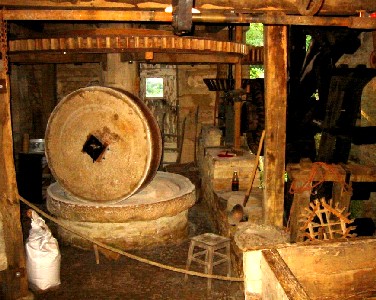
Mill, Of the Type Used to Express OIl
Quincy explains that the medicinal oils are "such
as are impregnated with some Medicinal Simples, generally Leaves or Flowers of Vegetables, by Boiling or Insolation [soaking in sunlight]. Those which are made from Flowers are best performed by Insolation; that is, steeping the Ingredients in [olive] Oil, in such a warmth as the Sun will give, and then straining off the Oil for use ...But OIls, which have frequently the green Leaves of Plants to draw out their Virtues from, stand in need of boiling: the usual standard is, until the Ingredients grow crispy."5
Like waters, oils are divided into two kinds: simple and compound. Nicholas Culpeper explains that simple oils are "such as are made of Fruits or Seeds by expression [pressing or squeezing], [while] Compound Oyls are made of Oyl of Olives, and other Simples imagine Herbs, Flowers, Roots &c."6 Since simple oils as defined by Culpeper require not compounding or processing, they are included in the Simples section.
1,2 John Quincy, Pharmacopoeia Officinalis & Extemporanea, 1719, p. 445; 3,4 Robert James, Pharmacopoeia Universalis, 1747, p. 176; 5 Quincy, p. 445; 6 Nicholas Culpeper, Pharmacopœia Londinesis, 1720, p. 278
Balsamum Catagmaticum
Listed in: Moyle-Composition: Balsamum Catagmaticum1
Category: Compound - Oils
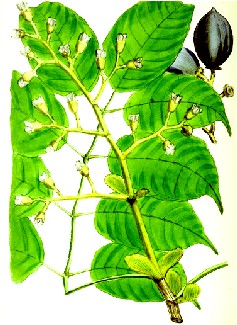
Manilla Elemi, From Medicinal Plants, Vol, 1,
By Robert Bentley & Henry Trimen, p. 60 (1880)
Rx: "Tereb. ven. [Venice Turpentine] {8 ounces}, Gum Elemi [resin of Canarium luzonicum tree] {3 ounces}, Razain [probably raisins] {1 ounce}, f. vitell Ov [egg yolks] {2 each} Pulv [powders of] Aristoloch. rotund. [Aristolochia rotunda] {1/2 ounce} Mastic. Olib. [olibanum - frankincense], Myrrh. Sang Drac. [Sanguis Draconis - dragon's blood resin] Croci Angliæ [English saffron], {of each 1 dram}, misce f. Balsam [mix into a balsam]."2
Description: "And because no Unctious [greasy] or Olious [oily] Medicine must be applied to the Bones or Joints, being wounded or shattered, I made up, and used this... Balsam, which is excellent in this case."3
Moyle also suggests this balsam be used in the cure of 'Boyls and Fellons [pus which forms and collects in the fingers]':
"But forthwith apply a warm and comfortable Cataplasm to the Tumour; (if in the beginning) let it be resolvent [able to reduce inflammation], emollient [softening] and anodine [able to eliminate pain]; as that in the Catalogue [referring to this balsam]... which if the Tumour be but a beginning, 'tis ten to one but it discusses [disperses] out the impact humour by way of dew"4.
1,2,3 John Moyle, The Sea Chirurgeon, 1693, p. 15; 4 Moyle, p. 125
Balsamum Consolida
Listed in: Moyle-Composition: Balsamum Consolida1
Category: Compound - Oils
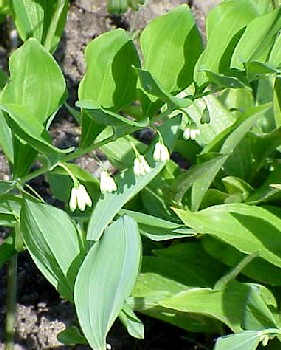
Photo: Kurt Stuber - Polygonatum Commutatum
Rx: "Rad. [roots of] Poligonati [Polygonatum], Cymphiti [Probably Symphytum - Comfrey], scind tenuiss. [finely shredded]. {of each 4 ounces}, fol. [leaves of] Bugula, Cauda equina [horse tail - Equisetum], Ophioglosson [Ophioglossum - adder's-tongue ferns], Panax colone [stachys palustris], Flor. [flowers of] Hyperic. [St. John's wort], minutis. incis. [sliced finely] {of each 2 handfuls}, Vin Hispan. [Spanish or Madiera wine] {2 pints}, Exung. Ovilla [Axungia ovillus - lard or fat of sheep] {1-1/2 pound} Porcin [Axungia porcini - lard or fat of pigs], {1 pound}, let the Roots and Herbs be first well beaten in a Morter, and then put in the Wine and Exungias [lards], and put it in a Vessel close covered, and set it to infuse in the Embers till the Exungias swim atop; then take it off, and let it stand infusing for seven days; at last boyl it to the consumption of the Wine, and strain it hard out whilst hot; Then add to the Unguen. [resins of] Gum Elemi [Canarium luzonicum tree], Tereb [terebinthina - turpentine], {of each 12 ounces}. Ol Cera. [Oil of Wax] {3 ounces}, Pulv. [powders of] Mastic. Oliban. [olibanum - frankincense] Borax [sodium borate], {of each 1 ounce}, boyl it till 'tis thoroughly mixt, then add Pulvis Croci [powdered saffron] {1 dram} and after it is stirred well together, let it cool, and keep it for use."2
Description: Of this balsam, Moyle explains it is "used in all manner of Wounds, whether in the Carnous [flesh] or Nervous parts, and in all parts of the Body from Head to Foot, and [I have] found it to exceed all other Balsams whatever."3 He later reaffirms that it "is the greatest healer of Wounds, either in Carnous or Nervous parts that ever I made use of. But we generally at Sea keep to the good old Balsamick Medicine; because it is best known, and well approved, and easier made, and cheaper withal."4 This provides some insight to the sea surgeon's need to balance economy of time and money with overall effectiveness.
1,2,3 John Moyle, The Sea Chirurgeon, 1693, p. 16; 4 Moyle, p. 61
Oleum Absinthii (Oil of Wormwood)
Listed in: Woodall-Chest: Oleum Absinthii1
Photo: H. Zell - Absinthi Artemisia Absinthium
Category: Compound - Oils
Humoral Property: "warm"2
Rx: "Of common [olive] Oyl {5 pounds} Tops of Wormwood {2 pounds} Juyce of the same {1 pound, 4 ounces} mingle them, and macerate them [soften them in the oil], as before prescribed."3
Description: "Oyle of wormewood dothe calefie [warm] and corroborate [strengthen], especially the stomacke, raiseth an appetite, concocteth [combines] crude humours, dissipateth and disperseth winde, killeth wormes, and take away obstructions proceeding from a colde cause, the parts greeved being annoynted therewith, and likewise is is good in Glisters [clysters - enemas] for the like occasions."2
1,2 John Woodall, the surgions mate, 1617, p. 73; 3 Nicholas Culpeper, Pharmacopœia Londinesis, 1720, p. 224; 4 Woodall, p. 73
Oleum Anethi (Oil of Dill)
Listed in: Woodall-Chest: Oleum Anethenium1
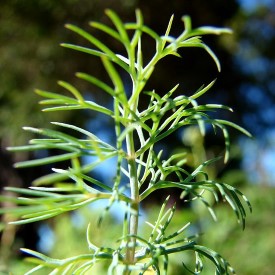
Photo: Forest and Kim Starr
Dill - Anethum Graveolens
Category: Compound - Oils
Rx: "Of common [olive] Oyl {2 pounds} flowers of Chamomile, or tops of Dill {1 pound} of the decoction of the same {half pound} mingle them, and insolate them [put them in the sun] for seven days, and boyl them till the watry part be evaporated; let this be repeated three or four times, and afterwards kept for use."2
Description: "Oyle of Dill is anodine [soothing] and laxative, it concocteth [combines] crude tumors, causeth sleepe, mittigateth the head-ach, refresheth the wearied members, strengthneth the sinewes, discusseth [disperses] winde, profitable for convulsions, and asswageth aches, easeth paines, and hath many other good uses."3
1 John Woodall, the surgions mate, 1617, p. 69; 2 John Quincy, Pharmacopoeia Officinalis & Extemporanea, 1719, p. 654; 3 Woodall, p. 69
Oleum Anisi (Oil of Anise)
Listed in: Woodall: Oleum Anisi1, Moyle: Oleum Anici.2, Tweedy: Oleum Anis.3
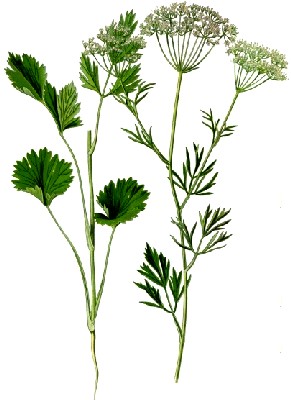
Artist: Franz Eugen Köhler
Anise, From Medizinal Pflanzen (1887)
Category: Compound - Oils
Rx: "Let a pound, or more or less of Anise-seed, be contended and macerated [soaked] some hours in eight or ten times as much water; then let it be put in a Copper Alembick [chemical still], with a vicine Refrigeratory [nearby cooling substance]; then let it be distilled, first with a moderate, afterwards a more valid fire; then segregate the Oyl from the water.
When the Water and Oyl thus ascend and descend together into a Receptacle, they must be sejoyned [separated]; which may be done by a Certain instrument like a Tunnel, whereinto the whole liquor must be injected; which must be so collocated [placed side by side], that the acuminated and angust [narrowing] part thereof, which should be obturated [blocked up] with wax, may hang downwards; and so the water will occupy the lowest, and the Oyl the highest place: the wax then being rubbed off, and the hole opened, the water will run out, and the Oyl stay."2
Description: "Oyle of Anis-seedes prevaileth against the collicke arising from winde and colde, against the Tympanie [swelling of the abdomen with gas], Inflation and crudity of the stomacke, against the gripings [pains] and the crying of the intestines, &c."8
1 John Woodall, the surgions mate, 1617, p. 76; 2 John Moyle, The Sea Chirurgeon, 1693, p. 34; 3 "158. John Tweedy's Bill for Medicines. November 8, 1743". Privateering and Piracy in the Colonial Period Illustrative Documents, John Franklin Jameson, ed., p. 457; 3 Jean de Renou, A Medicinal Dispensatory, 1657, p. 683-4; 4 Woodall, p. 76
Oleum Caryophillorum (Oil of Cloves)
Listed in: Woodall: Oleum Garyophillorum1, Moyle: Oleum Carioph.2
Category: Compound - Oils
Photo: Wiki User Miansari66 - Whole Cloves
Rx: Physician Robert James explains that distilling oils from simple substances is always performed in the same basic way, using the first such simple Oil (Absinthi or Wormwood) as his example and directing the other oils of simples such as Cloves be made the same way:
"Take any Quantity of the Plant of _____, moderated dried in the Shade, and cut to pieces; as much Spring Water as will commodiously keep it a-float, and a proper Quantity of Sea Salt to give the Liquor [liquid] a tolerable Sharpeness: let them steep together for for [sic] eight Days, then distil them by the Alembic [chemical still], with some-what smarter Fire, than what is usual in the Distillations of Waters, and afterwards separate the Oil form the Water, according to the Rules of Art."3
Description: "Oyle of Cloves not unlike to Opabalsamum in strength doth sweeten the breath, driveth away putrede humours, discusseth [disperses] winde, openeth the pores of the liver, digesteth colde humours, dissipateth the melancholicke humours [black bile, one of the bodily humors] healeth olde and new ulcers, staieth [stops] the putrefaction of the bones, and asswageth the paine of the teeth proceeding from a colde cause."4
"Oleum Cariophyllorum – Cloves. This is heavy and will sink in Water. There is some of this imported, which is made from the Bark of the Tree which produces this Spice, and is of a high red Colour; but that is best which is made here [England], and looks pale. ...It is very often prescrib’d, and in one Dose of a Cathartick [laxative], one Drop is an outside Proportion."5
1 John Woodall, the surgions mate, 1617, p. 75; 2 John Moyle, The Sea Chirurgeon, 1693, p. 34; 3 Robert James, Pharmacopoeia Universalis, 1747, p. 762; 4 Woodall, p. 76; 5 John Quincy, Pharmacopoeia Officinalis & Extemporanea, 1719, p. 369
Oleum Catellorum (Oil of Puppies)
Listed in: Moyle: Oleum Catellorum1
Category: Compound - Oils
Photo: Boris Dimitrov - New Welped Cur Puppies
Rx: "Take Sallet [olive] Oyl four pound, two Puppy-dogs newly whelped [born], Earth-worms washed in white Wine one pound; boyl the Whelps till they fall in pieces, then put in the worms a while after strain it, then with three ounces of Cypress Turpentine, and one ounce of Spirits of Wine, perfect the Oyl according to Art."2
Description: "It is excellent good to bath the Limbs and Muscles that have been weakned by Wounds or Bruises."3
"This Oil is of wonderfull force to asswage pain, to brink [bring] shot-wounds to suppuration [cause the formation of pus - thought to be the 'bad' humors coming out of the wound], and cause the falling away the Escar"4.
1 John Moyle, The Sea Chirurgeon, 1693, p. 34; 2,3 Nicholas Culpeper, Pharmacopœia Londinesis, 1720, p. 218; 4 Thomas Brugis, The Marrow of Physick, 1669, p. 48
Oleum Ceræ (Oil of Wax)
Listed in: Moyle: Oleum Cera.1
Category: Compound - Oils
Photo: Maša Sinreih - White Wax (Cera Alba)
Rx: "Take any quantity of wax, melt it with twice as much sand; put the mixture into a retort [a vessel with a long neck], and distil it in a sand heat [created by a sand furnace that heats a container of sand in which the vessels are set]; at first an acid spirit rises, and afterwards a thick oil, which adheres to the neck of the retort, unless it be warmed by applying a burning coal: this may be rectified [purified through repeated distillation] into a thin oil. by distilling it several times without mixture in a sand-heat."2
Description: "This last [purified] Oil of Wax is an incomparable Remedy for the Diseases of the nervous Papillæ on the external Skin; and has scarce its Equal in curing chapt Lips in the Winter, chapt Nipples in the Women who give Suck, and in the Cracking of the Skin of the Hands and Fingers, being sometimes gently anointed thereon. It is also serviceable in discussing [dispersing] cold Tumors arising on the Face or Fingers in the Winter; and curing contracted Tendons, and the Rigidity of the Limbs thence arising, being used with Baths, Fomentations, and Motion; for it has a singular Virtue in thus restoring Flexibility to the Parts: Being frequently rubbed upon the Abdomen, it prevents Costiveness [constipation]; and is therefore excellent in effectually curing the Diseases of Children."3
1 John Moyle, The Sea Chirurgeon, 1693, p. 34; 2 John Quincy, Pharmacopoeia Officinalis & Extemporanea, 1782, p. 272; 3 Robert James, Pharmacopoeia Universalis, 1747, p. 795
Oleum Chamomili (Oil of Chamomile)
Listed in: Woodall-Chest: Oleum Chamæmelinum1, Moyle: Ol. Camameli2
Category: Compound - OilsHumoral Property: warm [califies]3
Photo: Wiki User Kallerna
Camomile Matricaria Recutita
Rx: Physician Robert James explains that distilling oils from simple substances is always performed in the same basic way, using the first such simple Oil (Absinthi or Wormwood) as his example and directing the other oils of simples such as Flowers of Chamomile be made the same way:
"Take any Quantity of the Plant of _____, moderated dried in the Shade, and cut to pieces; as much Spring Water as will commodiously keep it a-float, and a proper Quantity of Sea Salt to give the Liquor [liquid] a tolerable Sharpeness: let them steep together for for [sic] eight Days, then distil them by the Alembic [chemical still], with some-what smarter Fire, than what is usual in the Distillations of Waters, and afterwards separate the Oil form the Water, according to the Rules of Art."4
Description: "Oyle of Chamemill resolveth moderately [removes things] and calefieth [warms], is good for the collicke, [bladder] stone, wearinesse, by anointing the parts greeved, and for aches, and fevers in all other things other with the former. It is also very convenient in Glisters [clysters - enemas] for all gripings and tortions [pains] of the gutts, and yeeldeth great comfort to the intrailes by the good odour and warmth thereof."5
"This Plant affords but a small quantity of this Oil, as all do which seed little, and therefore is dear. It is us'd chiefly... to correct Purgers [to lessen the force of purging medicines]; and sometimes also is given as a Carminative [used to prevent the formation of gas] in boles [clays], a Drop or two at a Dose; and does often good, in suddenly removing those Flatus's [buildup of gas in the intestines] which occasion Stitches and Pains of the Side."6
Modern Uses: German chamomile might be beneficial for upset stomach, children with diarrhea and infant cholic.7 Note that this is not medical advice and the author is not a medical professional. Side effects may include nausea, dizziness, allergic reactions and potentially can cause anaphylaxis. Chamomile has been found to interact with other drugs such as cyclosporine and warfarin.
1 John Woodall, the surgions mate, 1617, p. 70; 2 John Moyle, The Sea Chirurgeon, 1693, p. 34; 3 Woodall, p. 70; 4 Robert James, Pharmacopoeia Universalis, 1747, p. 762; 5 Woodall, p. 70; 6 John Quincy, Pharmacopoeia Officinalis & Extemporanea, 1719, p. 369; 7 Stephen Foster, "Chamomile", www.nccih.nih.gov, gathered 2/17/23
Oleum Excestrense (Oil of Exeter)
Listed in: Moyle: Oleum Excestrensis1
Category: Compound - Oils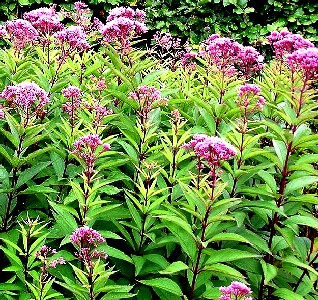
Photo: A. Barris - Eupatorium Purpureum
Rx: "Take of leaves of Wormwood, Centaury the less, Eupatorium, Fennel, Hysop, Bays, Marjoram, Balm [lemon balm or melissa], Nep [catnip], Penyroyal, Savin [juniper], Sage, Time, of each four ounces; Southern wood [Artemisia abrotanum], Betony, Chamepytis [Ajuga chamaepitys] and Lavender, of each six ounces; Rosemary one pound; the flowers of Chamomel, Broom, white Lillies, Elders, the seeds of Cummin and Fenugreek, the roots of Hellebore black and white, the bark of Ash and Lemmons, of each four ounces; Euphorbium, Mustard, Castolreum, Pellitory of Spain, of each an ounce; [olive] Oyle sixteen pound, Wine three pound; the herbs, flowers, seeds and Euphorbium being bruised, the Roots, Bark, and Castorcum cut, all of them infused twelve hours in the Wine and Oyl, in a warm Bath, then boiled with a gentle fire to the Consumption of the Wine and moisture, strain the Oyl and keep it."2
Description: "Many people by catching bruises when they are young, come to feel it when they are old; others by catching cold, catch a lameness in their Limbs; to both which I commend this soverign Oyl to bath their grieved members with."3
"May serve in lieu of hot Oils, and is good to anoint the Limbs of such as are lame, by reason of some cold, bruise, sprain, &c."4
1 John Moyle, The Sea Chirurgeon, 1693, p. 34; 2,3 Nicholas Culpeper, Pharmacopœia Londinesis, 1720, p. 219; 4 Thomas Brugis, The Marrow of Physick, 1669, p. 41
Oleum Hyperconis (Artificial Balm)
Listed in: Woodall-Chest: Balsamum artific1
Category: Compound - Oils
Photo: Wiki User Antramir - Collecting Turpentine
Rx: "Venice Turpentine, {1 pound}. Oyle of Bayes, that is perfect without mixture, {4 ounces}. Galbanum, {3 ounces}. Gum Arabic, {4 ounces}. Olibanum Mirrha elect, Gum Hederae, of each, {4 ounces}. Lignum Aloes, Galingal, Cloves, Consolida minore [lesser comfrey], Cinamon, Nutmegs, Zedoaria [Curcuma zedoaria - white tumeric], Ginger, Diptamnum album [white dittany], of each, {1 ounce}. Muske of Levant, Ambergriece of each one Drachme [dram]. Beat all those aforesaid things together, and put them into a Retort of Glasse well luted [sealed], and put thereto {6 pounds} of Rectified Aqua vitae without fleame [phlegm], and so let it stand {9} dayes, and then distill it by sand [created by a sand furnace that heats a container of sand in which the vessels are set], and there will come forth a white water mixed with Oyle, and so keep thy fire small, untill there come forth a blackish Oyle, then change thy Receiver, and sett hereto another, and increase thy fire untill all the spirits bee come forth, then separate the Oyle from the black water, and keep them by themselves and the like shall yee doe by the first water. The first water that is white, is called Aqua del Balsamo, and the Oyle separated from that is called Oleum del Balsamo. The second water that is black is called Mater Balsami, and the Oyle separated from that water, is called Balsamo artificiato, which would be kept as a precious Jewel."2
Description: "It is best to be used in wounds as hot as the Patient can endure it, and for the first time rather hotter. It is a sure medicine for all venomous wounds, all bitings of madde dogges, or of venomous wormes, very hot applied, and the parts about anointed therewith warme, remembring in all venomous griefes a Cordiall [medicine for the heart] is also requisite. In my owne practice it is almost all the unctuous medicine I ever use for the curing of wounds and contusions, and I never repented my selfe of the use thereof. In piercing wounds and stabs it is a medicine a Surgion may well rely on, it will not disgrace him. It is very comfortable medicine against all paines, aches, and witherings of the outward limes [limbs] proceeding of cold causes, using it warme with good frication [friction], and a plaster of Burgundy pitch spread on lether and applied thereon, or rather Empla: Stipticum Paracelsi."3
1 John Woodall, the surgions mate, 1617, p. 71; 2 Leonardo Fioravanti, An exact collection of the choicest and more rare experiments and secrets in physick and chyrurgery, 1517, p. 65; 3 Woodall, p. 71
Oleum Hyperici (Oil of St. John's Wort)
Listed in: Woodall: Oleum Hipericonis Simplex1, Moyle: Oleum Hypericon2, Tweedy: Oleum Hyperic.3
Category: Compound - Oils
Humoral Property: dry4; warm5
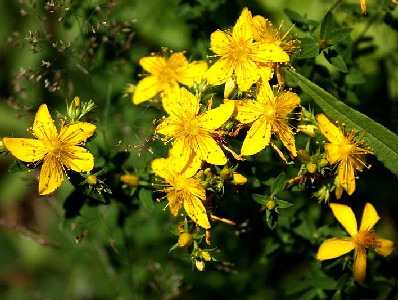
Photo: Leslie Seaton - St. John's Wort (Hypericum Perforatum)
Rx: "'Take Tops of the Plant [St. John's wort] when in flower {4 ounce) Oile of Olives {1 pound}. Let them stand together in the Sun some days, then press out the Oil, and put the same quantity of the Flowers to it two or three times more: the last time gently evaporate the aqueous Humidity which it receiv’d from the Plant, and strain it for use.'
In the College-Dispensatory there is order’d Turpentine {3 ounces} and {1 scruple} of Saffron; the former spoils the medicine for most Intentions, and the latter is ridiculous: this therefore is the way the Shops now make it."6
Description: "Oyle of St. Johns worte simples is of a thin essence: it is of temperament dry and anodine, healing sinewes pricked or wounded. Also it is very profitable to them that have the Sciatica to annoint them against the swellings of the Temples, Belly, and leggs throug[h] Melancholie [black bile, one of the bodily humors]: and it is of very good use for cold aches and convulsions, cramps, burnings, scaldings, and good to cure new wounds."7
1 John Woodall, the surgions mate, 1617, p. 70; 2 John Moyle, The Sea Chirurgeon, 1693, p. 34; 3 "158. John Tweedy's Bill for Medicines. November 8, 1743". Privateering and Piracy in the Colonial Period Illustrative Documents, John Franklin Jameson, ed., p. 457; 4 Woodall, p. 70; 5,6 John Quincy, Pharmacopoeia Officinalis & Extemporanea, 1719, p. 448; 7 Woodall, p. 70
Oleum Juniperi (Oil of Juniper)
Listed in: Woodall: Oleum Juniperinum1, Tweedy: Oleum Juniper.2
Category: Compound - Oils
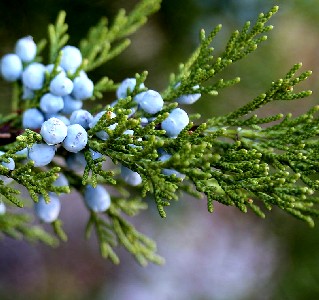
Photo: Wiki user Dcrjsr - Juniper Berries
Rx: "An idoneous [suitable] quantity of Juniper-berries must be put into a figuline vessel [one made of clay], with a foraminous [opening - apparently meaning the body of the vessel is larger than the neck] bottome; whereunto, the orifice of another vessel must be adjoined, and glewed with tenacious argil [clay], or glutinous paste: they must be so disposed, that the empty one may be put in some hole, and covered with earth; the other, which contains the Juniper, must be above the earth: which when the fire is accended all about it, will demit [give up] its oleaginous pinguetude [greasy and fatty substance] into the pot underneath it."3
Description: "Oyle of Juniper is commended for the cure of the morphew [blemishes] of the skin, it provoketh urine, it agreeth with the cure of diseases of the reines [kidneys], it is good to bee taken certaine drops thereof against any pestilential vapours, for the [kidney] stone, it is also good, and to be drunke certaine drops, against penetrating wounds."4
1 John Woodall, the surgions mate, 1617, p. 76; 2 "158. John Tweedy's Bill for Medicines. November 8, 1743". Privateering and Piracy in the Colonial Period Illustrative Documents, John Franklin Jameson, ed., p. 457; 3 Jean de Renou, A Medicinal Dispensatory, 1657, p. 676; 4 Woodall, p. 76
Oleum Laurinum (Oil of Bays)
Listed in: Woodall-Chest: Oleum Laurinum.1
Category: Compound - Oils
Humoral Property: "calefying [warming]"2
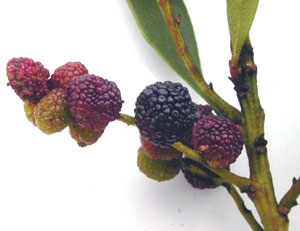
Bayberries - Myrica Faya Plant
Rx: "Oil of Bays may be procured from bay-berries, both by expression, and by pounding and boiling them in water; when the oil, which smells like the berries, and it is thick and greenish, floats, and may be skimmed off. It is sometimes used instead of lard, for making mercurial ointment. The expressed oil is very thin."3
Description: "Oyle of Bayes is a medicine... mollifying [soothing], opening and discussing [dispersing], it doth much mitigate the Collicke delivered into the body by glister [clyster - enema], it is a present remedy against colde griefes of the braine, nerves, arteries and loynes [loins], the parts annoynted therewith, it represseth the violence of a fever the spina dorsi or region of the backe bone annoynted therewith, and is good for the Palsie, Sciatica, the hardnesse and paines of the spleene, and is much used for to cure the scab, and ring-worme, and in the cure of the Scurvy."4
1,2 John Woodall, the surgions mate, 1617, p. 72; 3 James Rennie, A New Supplement to the Pharmacopœpias of London, Edinburgh, Dublin and Paris, Baldwin and Cradock, 1833, p. 271; 4 Woodall, p. 72-3
Oleum Lavendulæ (Oil of Lavender)
Listed in: Tweedy: Ol. Lavend.1
Category: Compound - Oils
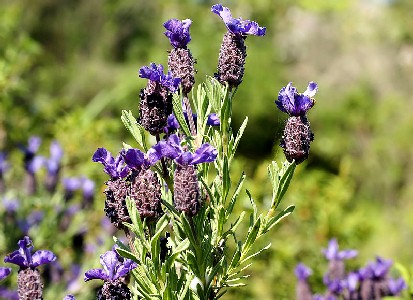
Photo: Hans Hillewaert - Lavender (Lavandula Stoechas)
Rx: Physician Robert James explains that distilling oils from simple substances is always performed in the same basic way, using the first such simple Oil (Absinthi or Wormwood) as his example and directing the other oils of simples such as Lavender be made the same way:
"Take any Quantity of the Plant of _____, moderated dried in the Shade, and cut to pieces; as much Spring Water as will commodiously keep it a-float, and a proper Quantity of Sea Salt to give the Liquor [liquid] a tolerable Sharpeness: let them steep together for for [sic] eight Days, then distil them by the Alembic [chemical still], with some-what smarter Fire, than what is usual in the Distillations of Waters, and afterwards separate the Oil form the Water, according to the Rules of Art."2
Description: "This has much of the Scent and Virtues of the Plant, but is seldom or never prescrib'd singly; but as it makes a part in some other Compoisitions. It is sometimes dropped upon the Volatile Salts [smelling salts - Spirit of Hartshorn] for Smelling-Bottles, and its Flavour in them is very agreeable."3
Of Lavender plants, apothecary John Quincy says, "They are by all rank'd amongst the Cephalicks [medicines for treating problems of the head], and some ascribe to them the same virtue as Hyssop, which comes under another Class, as a Pectoral [medicines for treating problems with the chest]."4
Modern Uses: Oil of lavender may be beneficial for anxiety. Note that this is not medical advice and the author is not a medical professional. Topical use may cause allergic reactions.5
1 "158. John Tweedy's Bill for Medicines. November 8, 1743". Privateering and Piracy in the Colonial Period Illustrative Documents, John Franklin Jameson, ed., p. 460; 2 Robert James, Pharmacopoeia Universalis, 1747, p. 762; 3 John Quincy, Pharmacopoeia Officinalis & Extemporanea, 1719, p. 370; 4 Quincy, p. 82; 5 Stephen Foster, "Lavender", www.nccih.nih.gov, gathered 2/17/23
Oleum Liliorum (Oil of Lillies)
Listed in: Woodall-Chest: Oleum Lilliorum1, Moyle: Oleum Liliorum2
Category: Compound - Oils
Humoral Property: "calefies [warms] moderately"3, "doth moderately warm"4
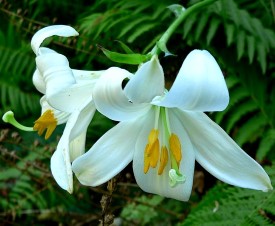
Photo: Stan Shebs - Lilium Candidum
Rx: "Of mature [olive] Oyl {2 pounds} of the flowers of Lillies detracted [removed] from their yellow filaments {1/2 pound or 7.5 ounces} macerate [soften by soaking], and insolate them [expose them to sunlight]; and by iterating [repeating] maceration [soaking to soften] and insolation [exposure to the sun], let the Oyl be made as before described."5
Description: "Oyle of Lillies doth moderately ... resolve [remove], asswageth paine, mollifieth [softens] hard tumours, dothe much mitigate [lessen] the violence of diseases, and is very effectuall against paines of the breast and stomacke, and allayeth the inordinate heate of the reynes [kidneys] and bladder."6
"It ...resolves, allays dolours [griefs - pains], from what cause soever; mitigates all acrimony [bitterness], and tempers all the ardours and dolours of the Breast, Ventrical, Reins [kindeys], Uterus, and Bladder."7
1 John Woodall, the surgions mate, 1617, p. 70; 2 John Moyle, The Sea Chirurgeon, 1693, p. 34; 3 Jean de Renou, A Medicinal Dispensatory, 1657, p. 652; 4 Woodall, p. 70; 5 Renou, p. 652; 6 Woodall, p. 70; 7 Renou, p. 652
Oleum Limoniorum (Oil of Lemons)
Listed in: Woodall-Chest: Oleum Limoniorum1
Category: Compound - Oils
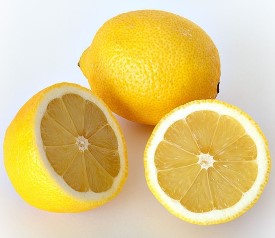
Photo: Andre Karwath - Lemons
Rx: "Lemon-peel. Consists of an interior layer, which is without taste, and not easily digested, and an exterior, which is aromatic, warm, and bitterish, containing a volatile essential oil, which is obtained by rubbing the rind on lump sugar, or by distillation. The latter, however, is inferior, in consequence of the empyreuma [the smell and taste associated with burning it], which can seldom be avoided in the process."2
Description: "Medicinally it is used, combined with water, as a refrigerant [coolant] in fevers, and as an antiseptic in sea-scurvy and scarlatina maligna [severe scarlet fever]."3
"This is made of the Peels, in the same manner as that of the Oranges; and agrees with it in its medicinal Virtues: it is very rarely prescrib'd"4. Of Ol. Aurantiorum or Oil of Oranges, John Quincy says it is "Carminative [used to prevent the formation of gas] and Cephalick [good for treating problems of the head]"5
It is interesting that this is rarely prescribed according to land-based physician Quincy since yet is recommended by sea surgeon John Woodall for inclusion in his medicine chest. This may hint at its perceived value as a cure for scurvy, although without substantiating comments from either author, this is not clear.
1 John Woodall, the surgions mate, 1639, Diagram opp. page 26; 2,3 James Rennie, A New Supplement to the Pharmacopœpias of London, Edinburgh, Dublin and Paris, Baldwin and Cradock, 1833, p. 218; 4 John Quincy, Pharmacopoeia Officinalis & Extemporanea, 1719, p. 370; 5 Quincy, p. 369
Oleum Lumbricorum (Oil of Earthworms)
Listed in: Woodall-Chest: Oleum Lumbricorum.1
Category: Compound - Oils
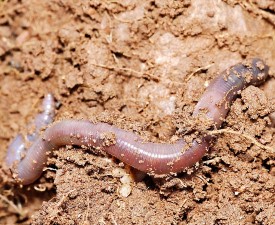
An Earthworm
Rx: "'Take Earth-Worms well cleansed {1/2 pound} Oile of Olives {2 pounds} White Wine {1/2 pound} Boil together till the Wine is evaporated, and the Worms are become crispy, and then strain out the Oil for use.'"2
Description: "Oyle of Earth-wormes helpeth the aches of the joynts in any part of the body, and doth strengthen and comfort well the sinewes weakned and pained, and against convulsions and cramps: and it is also a good Balme for sinowes wounded."3
"This comes to us for a penetrating and anodyne [pain relieving] Medicine, and is therefore recommended in Athritick Pains, in Cramps, old Aches, Numbness, Palsies, and rickets: but they who trust [too] much to it in those cases, will be disappointed. Indeed these things which we reject as ineffectual in those obstinate Cases, may possibly have their use in subordination to other Means of more efficacy; therefore here we would be understood only, that they are by no means to be depended upon alone."4
1 John Woodall, the surgions mate, 1617, p. 70; 2 John Quincy, Pharmacopoeia Officinalis & Extemporanea, 1719, p. 448-9; 3 Woodall, p. 70; 4 Quincy, p. 449
Oleum Macis (Oil of Mace)
Listed in: Woodall: Oleum Macis.1
Category: Compound - OilsHumoral Property: "doth calify [warm]"2
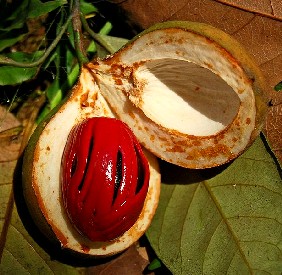
Photo: W.A. Djatmiko - Nutmeg and Hull
Rx: Physician Robert James explains that distilling oils from simple substances is always performed in the same basic way, using the first such simple Oil (Absinthi or Wormwood) as his example and directing the other oils of simples such as Mace or Nutmeg Hull be made the same way:
"Take any Quantity of the Plant of _____, moderated dried in the Shade, and cut to pieces; as much Spring Water as will commodiously keep it a-float, and a proper Quantity of Sea Salt to give the Liquor [liquid] a tolerable Sharpeness: let them steep together for for [sic] eight Days, then distil them by the Alembic [chemical still], with some-what smarter Fire, than what is usual in the Distillations of Waters, and afterwards separate the Oil form the Water, according to the Rules of Art."3
Description: "Oyle of mace doth ...digest colde humours, roborate [strengthens] the stomacke, helpeth concoction [digestion or combination of foods], raiseth an appetite, and procureth many other benefits to him that useth it."4
"[Oil of] Mace, this differs little from that of the [Oil of] Cloves, and is seldom made, and rarely prescrib’d"5.
1,2 John Woodall, the surgions mate, 1617, p. 75; 3 Robert James, Pharmacopoeia Universalis, 1747, p. 762; 4 Woodall, p. 75; 5 John Quincy, Pharmacopoeia Officinalis & Extemporanea, 1719, p. 370
Oleum Origani (Oil of Oregano)
Listed in: Woodall: Oleum Origani1
Category: Compound - Oils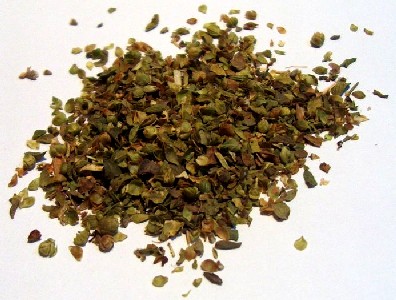
Photo: Wiki User Henna - Dried Oregano
Rx: ""Oleum Origani. ...Oil of Origanum or Marjoram. Procured by distillation from the dried herb. It has the fragrant aroma of the plant, and is acrid, pungent, of a yellow colour, and 9090 of spec. grav.
Adulterated [by unscrupulous sellers] with about a third or more of oil of turpentine, coloured with petroleum, which may be detected by burning with a dense black smoke. It is not good if made within the year, and it varies also very much with the dryness or wetness of the season, and with the soil where the plant grows. The best way to ascertain its Goodness is to rub a little between the palms, and to observe the odour which is exhaled."2
Description: "Oyle of Origanum cureth melancholy, helpeth the dropsie [edema], and cureth the cough, and quarterne fever [quartan fever - a malarial fever recurring every three days], and the tooth-ach."3
1 John Woodall, the surgions mate, 1617, p. 77; 2 James Rennie, A New Supplement to the Pharmacopœpias of London, Edinburgh, Dublin and Paris, Baldwin and Cradock, 1833, p. 283-4; 3 Woodall, p. 77
Oleum Overum (Oil of Eggs)
Listed in: Woodall: Oleum Overum1
Category: Compound - Oils
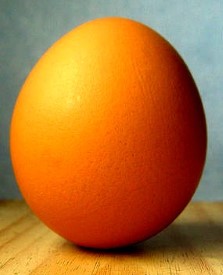
Photo: Kacper Aniolek - A Brown Egg
Rx: "Boyl the Yolks till they be hard, and bruise them with your hands with a Pestle and Mortar; heat them in an earthen vessel glassed until they begin to froth, stirring them diligently, that they burn not, being hot, put them in a linnen bag, and sprinkle them with Aromatick Wine, and press out the oyl according to Art."2
Description: "Oyle of Eggs clenseth the skin, taketh away the filthinesse, and all skars thereof occasioned by cutts, or bitings, or at the least much diminisheth them, so that they can be hardly seene: it cureth burnings, killeth Ringwormes, healeth excoriations, and is prevalent against any ulcer, chops, or ill matter arising out of the flesh, either in the hands, feete, armes, legs, or in any other part of the body."3
"It is profitable in Fistulaes and malignant Ulcers. It causeth the hair to grow, it clears the skin, and takes away Deformities thereof viz. Tetters, Ring worms, Morphew [a skin blemish], Scabs. I suppose none is so simple to take it inwardly to clear the Skin, nor to anoint their feet to take away the deformities of the Face."4
1 John Woodall, the surgions mate, 1617, p. 72; 2 Nicholas Culpeper, Pharmacopœia Londinesis, 1720, p. 213; 3 Woodall, p. 72; 3 Culpeper, p. 213
Oleum Papaverum (Oil of Poppies)
Listed in: Woodall: Oleum Papanerum1
Category: Compound - Oils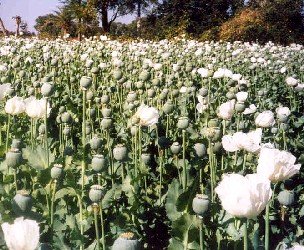
Poppy Crop in Malwa, India
Rx: "Oleum Papaveris. Oil of Poppies. This is made of the flowers, heads and leaves of garden poppies, of oil of olives in the same manner as oil of dill."2
For Oil of Dill, John Quincy says,
"It is made with {1 pound} of Oil, and {4 ounces} of the Flowers and Leaves of Dill, three times repeated, as before."3 Based on this description, this oil is apparently made by soaking.
Description: "Oyle of Poppies cureth the intemperature of heat in the reines [kidneys] and fevers, and procureth sleepe being annoynted on the nose, temples or eares, maketh lubricke [lubrice - slippery], and lenefieth [softens] the sharpe arterie."4
1 John Woodall, the surgions mate, 1617, p. 73; 2 John Quincy, Pharmacopoeia Officinalis & Extemporanea, 1722, p. 495; 3 Quincy, p. 494; 4 Woodall, p. 73
Oleum Roris Marini (Oil of Rosemary)
Listed in: Tweedy: Ol. Rorismarin.1
Category: Compound - Oils
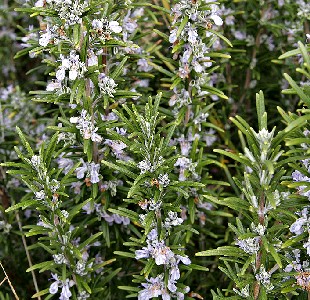
Photo: flagstaffotos - Rosemary Bush in Flower
Rx: Physician Robert James explains that distilling oils from simple substances is always performed in the same basic way, using the first such simple Oil (Absinthi or Wormwood) as his example and directing the other oils of simples such as Rosemary be made the same way:
"Take any Quantity of the Plant of _____, moderated dried in the Shade, and cut to pieces; as much Spring Water as will commodiously keep it a-float, and a proper Quantity of Sea Salt to give the Liquor [liquid] a tolerable Sharpeness: let them steep together for for [sic] eight Days, then distil them by the Alembic [chemical still], with some-what smarter Fire, than what is usual in the Distillations of Waters, and afterwards separate the Oil form the Water, according to the Rules of Art."2
Description: "This loses little or nothing of the Plant, and is best drawn when it is in Flower."3 Of the plant, Thomas Brugis says it is "cephalic [good for problems of the head], epatic [hepatic - good for problems with the liver], splenetic [problems of the splene], hysteric, stays fluxes [flows], and comforts the heart."4
1 "158. John Tweedy's Bill for Medicines. November 8, 1743". Privateering and Piracy in the Colonial Period Illustrative Documents, John Franklin Jameson, ed., p. 460; 2 Robert James, Pharmacopoeia Universalis, 1747, p. 762; 2 John Quincy, Pharmacopoeia Officinalis & Extemporanea, 1722, p. 368; 4 Thomas Brugis, The Marrow of Physick, 1669, p. 153
Oleum Rosarum (Oil of Roses)
Listed in: Woodall-Chest: Oleum Rosarum1, Moyle: Oleum Rosarum2
Category: Compound - Oils
Humoral Property: cool3
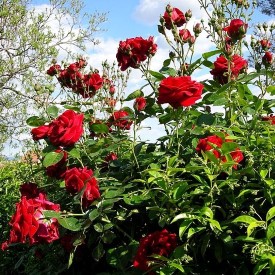
Photo: Wiki User Yellow Cat - Red Roses
Rx: "Of common [olive] Oyl washed {4 pounds} fresh Rose-leaves {1.5 pounds} infusion of Roses {1 pound} put them into a close vessel well covered; insolate them [put them in sunlight] for seven days; then boyl them in a strong vessel on a gentle fire for half an hour: afterwards let the flowers be expressed, new put in; and this repeated three times; at last, what Oyl is pressed out, preserve for use."4
Description: "Oyle of Roses, is anodine [soothing], and doth refrigerate and corroborate, and therefore is good against hot diseases, as Erysriphilas [red skin - St. Anthony's Fire]. Also with Mel Rosarum it is a good Balme for new wounds of the head, and else where; and hath divers other worthy uses in Chirurgery."5
"Oil of Roses (the stomach being anointed with it) strengthens it, cools the heat of it, thickens, takes away inflammation, abates swellings."6
1 John Woodall, the surgions mate, 1617, p. 69; 2 John Moyle, The Sea Chirurgeon, 1693, p. 34; 3 Woodall, p. p. 69; 4 Jean de Renou, A Medicinal Dispensatory, 1657, p. 650; 5 Woodall, p. p. 69; 6 Nicholas Culpeper, Pharmacopœia Londinesis, 1720, p. 218
Oleum Sambuci (Oil of Elder Flowers)
Listed in: Woodall-Chest: Oleum Sambucinum1
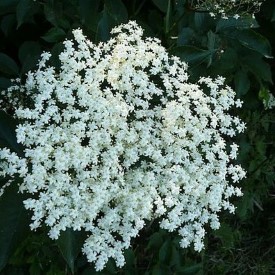
Photo: Graham Horn - Elder Flowers
Category: Compound - Oils
Rx: "Oil of Elder-Flowers is made by boiling one part of elder-flowers in two parts of olive oil, till the flowers are crisp, when the whole is to be pressed, and put aside to clear."2
Description: "Oyle of Elder flowers doth lenifie [soften] and purge the skin, is good for the obstructions of the Liver, helpful for the joynts and nerves pained, the parts greeved being anointed therewith: it procureth stooles by Glisters [clysters - enemas] used, healeth the yellow jaundice, amendeth belly ach, and easeth the griping paines thereof."3
1 John Woodall, the surgions mate, 1617, p. 72; 2 Nicholas Culpeper, Pharmacopœia Londinesis, 1720, p. 224; 3 Woodall, p. 72
Oleum Scorpionum (Oil of Scorpions)
Listed in: Woodall-Chest: Oleum Scorpionum1
Category: Compound - Oils
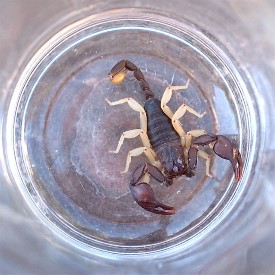
Photo: Jimmy Kreislauf
A Scorpion - Euscorpius Flavicaudis
Rx: "'This is made only by digesting thirty Scorpions forty days in Oil of Almonds {2 pounds}'"2
Description: "Oyle of Scorpions is of speciall use to breake the stone in the reines [kidneys] and bladder, and [Johannes] Manardus [16th century Italian physician] commendeth it both in the pestilence, all contagion, & fevers, but cheefely in expelling poyson. And it is also good to asswage the paines of the backe proceeding by distempered kidneyes."3
"Some antient Authors laid great stress upon this Medicine, and contriv'd many elaborate and troublesome Preparations and Compositions of it; particularly Mesue [8th/9th Assyrian physician Yuhanna ibn Masawaih] and Mathilus [Matheolus Perusinus, 15th century professor of medicine], some of whose Prescriptions [Johann] Zwelfer [16th century German physician and apothecary] gives in the Augustan Dispensatory: but they are such utter strangers in our Practice, as not to justify our taking up any room with them here; as also is the Oil of Vipers, and many others of the same Tribe."4
1 John Woodall, the surgions mate, 1617, p. 73; 2 John Quincy, Pharmacopoeia Officinalis & Extemporanea, 1719, p. 448-9; 3 Woodall, p. 73; 4 Quincy, p. 449
Oleum Spicæ (Oil of Spike)
Listed in: Woodall-Chest: Oleum Spicæ.1
Category: Compound - Oils
Humoral Property: "doth califie [warm]"2
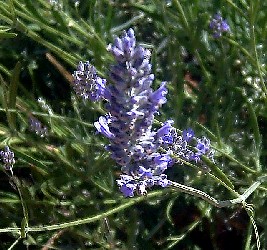
Photo: Javier Martin - Lavandula Latifolia
Rx: "Let the greater Spike, or latifolious Lavender, be macerated [softened] in white odorate wine, distilled through an Alembick [alchemical still], and then its oleous liquor [oily liquid] segregated from its watry [parts], and kept."3
Description: "Oyle of Spicke doth ...attenuate [reduce the force of things], discusse [dissipate], and is very profitable to them that have the gowt proceeding of a colde cause, or to comfort any member benumbed, also it is good against the falling sicknesse [epilepsy] and convulsions, the temples and nape of the necke, yea, and the whole head to be annoynted therewith is very profitable."4
"This Oyl is seldome used alone, but often mixed with other, especially Topical Medicaments; as the Vigonian salve; and is adhibited [applied] to many more uses, besides Medicinal ones."5
1,2 John Woodall, the surgions mate, 1617, p. 76; 3 Jean de Renou, A Medicinal Dispensatory, 1657, p. 684; 4 Woodall, p. 76; 5 Renou, p. 684

